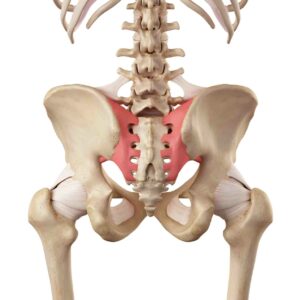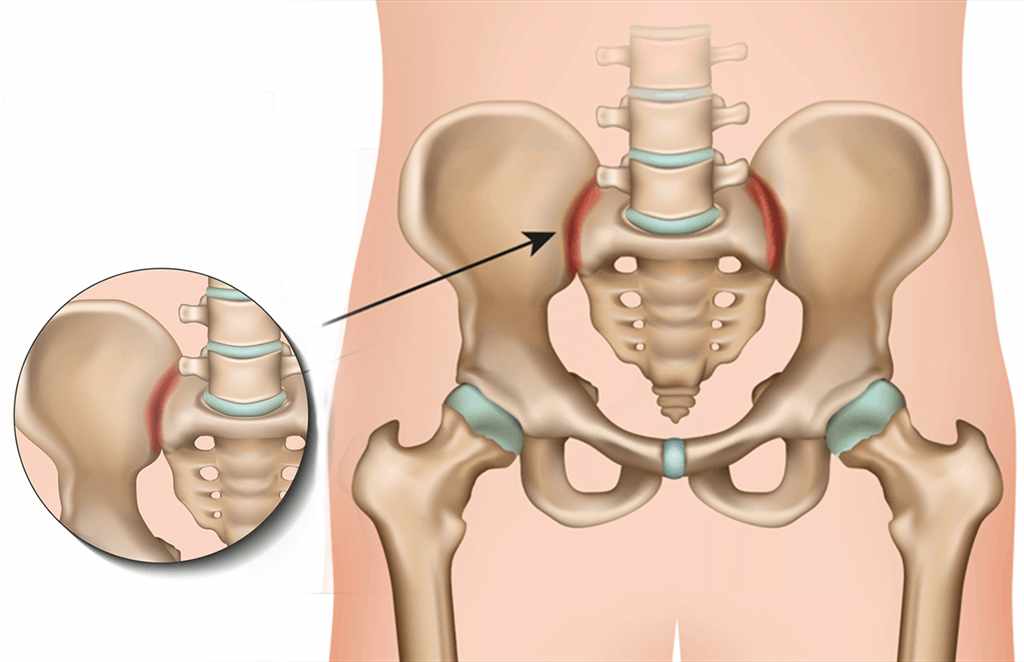If you are like many people, you have never heard of SIJ dysfunction until now. But don’t worry, you are not alone! The truth is, SIJ dysfunction is a relatively unknown condition. However, that doesn’t mean it isn’t important. In this blog post, we will discuss what SIJ dysfunction is and how you can treat it!
Contents
What Is SIJ Dysfunction?

The sacroiliac joint (SIJ) is the largest weight-bearing joint in the body and is located between the sacrum and iliac bones in the pelvis. The SIJ connects the spine to the pelvis and lower extremities and transfers weight from the upper body to the lower limbs. It also allows for a small amount of movement between the bones to accommodate for changes in position and weight distribution.
SIJ dysfunction is a condition that occurs when the SIJ is not able to move properly. This can be due to a number of different factors, including injury, pregnancy, and arthritis.
Signs And Symptoms
The symptoms of SIJ dysfunction can vary depending on the individual and the severity of the condition. However, some common symptoms include:
- Chronic pain in the lower back or pelvis
- Pain that radiates from the lower back or pelvis into the legs or buttocks
- Pain that is worse with sitting, standing, or walking
- Stiffness in the lower back or pelvis
- Instability in the lower back or pelvis
- Decreased range of motion in the lower back or pelvis
If you experience any of these symptoms, it is important to see a doctor or other healthcare provider to rule out other possible causes of your pain.
What Are The Causes?
The various causes of SIJ dysfunction are as follows:
Trauma
Any kind of trauma to the pelvis can lead to SIJ dysfunction. This includes both direct and indirect trauma. Direct trauma would be something like a fall or a car accident, while indirect trauma would be from activities that put stress on the pelvis over time, such as running or biking.
Pregnancy
The added weight and changes in the center of gravity that come with pregnancy can put a lot of stress on the SIJs.For instance, one study found that up to 50 percent of pregnant women have some degree of SIJ pain. Pregnancy can also lead to SIJ dysfunction due to the extra weight and strain that is placed on the pelvis. This is especially true in the third trimester when the baby is getting bigger and putting more pressure on the SIJs.
Age
The SIJs can wear down over time, which can lead to pain and dysfunction. This is especially true if you’ve had a previous injury to the area. For instance, if you’ve had a fall and landed on your tailbone, this can lead to SIJ problems later on in life. The likelihood of developing SIJ problems increases with age. This might be due to the wear and tear that occurs on the joints over time.
Obesity
Obesity can also lead to SIJ dysfunction because of the extra weight and strain that is placed on the pelvis. This is especially true if you are carrying most of your weight in your abdomen. For example, if you are obese and also have weak abdominal muscles, your abdomen will protrude forward. This puts a strain on the lower back and pelvis, which can lead to SIJ dysfunction.
Repetitive motions
Certain occupations or activities that involve repetitive motions can put added stress on the SIJs and lead to pain. These activities might include driving a truck, operating a jackhammer, or playing tennis. For instance, truck drivers who spend long hours driving might be at an increased risk for SIJ problems.
Occupational factors
People who have jobs that require them to twist their bodies, lift heavy objects, or stand for long periods of time might be more likely to develop SIJ dysfunction. For example, factory workers who operate machinery, carpenters, painters, and plumbers are all at an increased risk for developing this condition. Certain sports can also put athletes at a higher risk for developing SIJ dysfunction. These sports include golf, hockey, football, and rugby.
Gender
Women are more likely than men to experience SIJ problems. This might be due to the fact that women have wider hips, which can put added stress on the SIJs.For example, a woman’s body produces a hormone called relaxin. This hormone helps to loosen the ligaments in the pelvis so that the baby can pass through the birth canal. This increased flexibility can lead to instability in the SIJs and increase the risk of developing SIJ dysfunction.
Inflammatory diseases
Conditions like rheumatoid arthritis or ankylosing spondylitis can lead to inflammation in the SIJs, which can then lead to dysfunction. For instance, in rheumatoid arthritis, the body’s immune system attacks the synovium (the tissue that lines joints), resulting in inflammation and pain. Ankylosing spondylitis is a form of arthritis that primarily affects the spine, but can also lead to SIJ pain and dysfunction.
Hormonal changes
Changes in hormone levels, such as those that occur during menopause, can also lead to SIJ dysfunction.For instance, the loss of estrogen during menopause can cause the ligaments supporting the SIJ to weaken, leading to instability and pain.
So, these are the causes of SIJ dysfunction.
Treatment Options

There are various treatment options which are as follows:
Physiotherapy
It is a type of treatment that helps in improving the mobility of the joints and muscles. It also helps in reducing pain and inflammation. For instance, exercises like stretching, yoga, and massage can be very helpful in treating SIJ dysfunction.
- Stretching: A good way to combat SIJ dysfunction is to stretch the surrounding muscles. This can help to take the pressure off of the joint and allow it to heal properly.
- Yoga: Yoga is another great way to help improve SIJ dysfunction. The various positions and stretches that are involved in yoga can help to stretch and strengthen the muscles around the joint, which can help to take the pressure off of the joint and allow it to heal properly.
- Acupuncture: Acupuncture is another popular treatment option for SIJ dysfunction. The needles used in acupuncture can help to stimulate the muscles and nerves around the joint, which can help to reduce pain and inflammation.
Exercises
There are certain exercises that can help strengthen the muscles around your joints and also improve your flexibility. For instance, you can try Pilates to increase the range of motion in your hips and help relieve pain. You can also do specific exercises that target the muscles around your SIJ, such as the gluteus medius. It’s important to focus on strengthening and stretching the muscles around your hip
Chiropractic treatment
It is a type of treatment that uses manual manipulation to improve the function of the joints. It is very effective in treating SIJ dysfunction. For example, a study conducted in 2014 showed that chiropractic treatment was effective in reducing pain and improving function in people with SIJ dysfunction.
Surgery
It is the last resort option and is only recommended if the other treatments have failed to work. For instance, if you have a loose or damaged ligament, your doctor may recommend surgery to repair it. If you have arthritis, your doctor may recommend surgery to fuse the joints together.
Reduction of weight
If you are overweight, then reducing your weight can help in reducing the stress on your joints and also help reduce inflammation. For example, overweight people are more likely to suffer from arthritis, which is a condition that causes inflammation in the joints.
Heat or ice therapy
Applying heat or ice to the affected area can help in reducing the pain and inflammation. For instance, you may use a heating pad set on low or wrap an ice pack in a towel and place it on the area for about 15-20 minutes.
Manual therapy
A qualified therapist can provide manual treatment to release any tightness in the muscles and ligaments around the SIJ. This will help to improve mobility and reduce pain. For instance, a therapist may use:
- Mobilizations: slow, passive movements that help to increase the range of motion
- Manipulations: quick, purposeful movements that help to restore normal alignment
- Soft tissue work: techniques such as massage and stretching to release tension in the muscles
- Joint injections: these may be used if other treatments haven’t worked, and can help to reduce pain and inflammation
Education
It is important to understand what is causing your SIJ dysfunction in order to properly treat it. Your doctor may refer you to a physical therapist for education on the anatomy and function of the SIJ, pain management, and exercises.
Medications
Pain medications such as NSAIDs (non-steroidal anti-inflammatory drugs) can be used to relieve pain and inflammation. For instance, over-the-counter medications such as ibuprofen (Advil, Motrin IB) and naproxen (Aleve) can be effective. If these don’t work, your doctor may prescribe a stronger medication.
Lifestyle changes
Some lifestyle changes such as, avoiding high-impact activities, and wearing supportive shoes can help in managing the condition. For example, this can help reduce the load on the joints and may help to improve symptoms. People with SIJ dysfunction should avoid high-impact activities, such as running, jumping, or contact sports. These activities can put extra stress on the joints and may worsen symptoms. Wearing supportive shoes, such as those with good arch support, can help to take the strain off of the joints and may help to improve symptoms.
SIJ dysfunction is a condition that can cause pain and discomfort in the lower back, hips, and legs. There are various treatment options available that can help in managing the symptoms.
Conclusion
It may be concluded that SIJ dysfunction is a condition that can be caused by various factors. While it is often seen in women, it can also occur in men. Treatment options vary depending on the severity of the condition but may include physical therapy, exercises, and/or injections. Surgery is typically only recommended if other treatments have failed.
While SIJ dysfunction can be a painful and debilitating condition, there are treatment options available. With the help of a medical professional, you can find the best course of treatment for you and start on the road to recovery.
Physical Therapy help patients recover from pain. If you’re experiencing Back pain, Shoulder pain, Knee pain, Neck pain, Elbow pain, Hip pain, or Arthritis pain, a physical therapist at MantraCare can help: Book a physiotherapy session.


